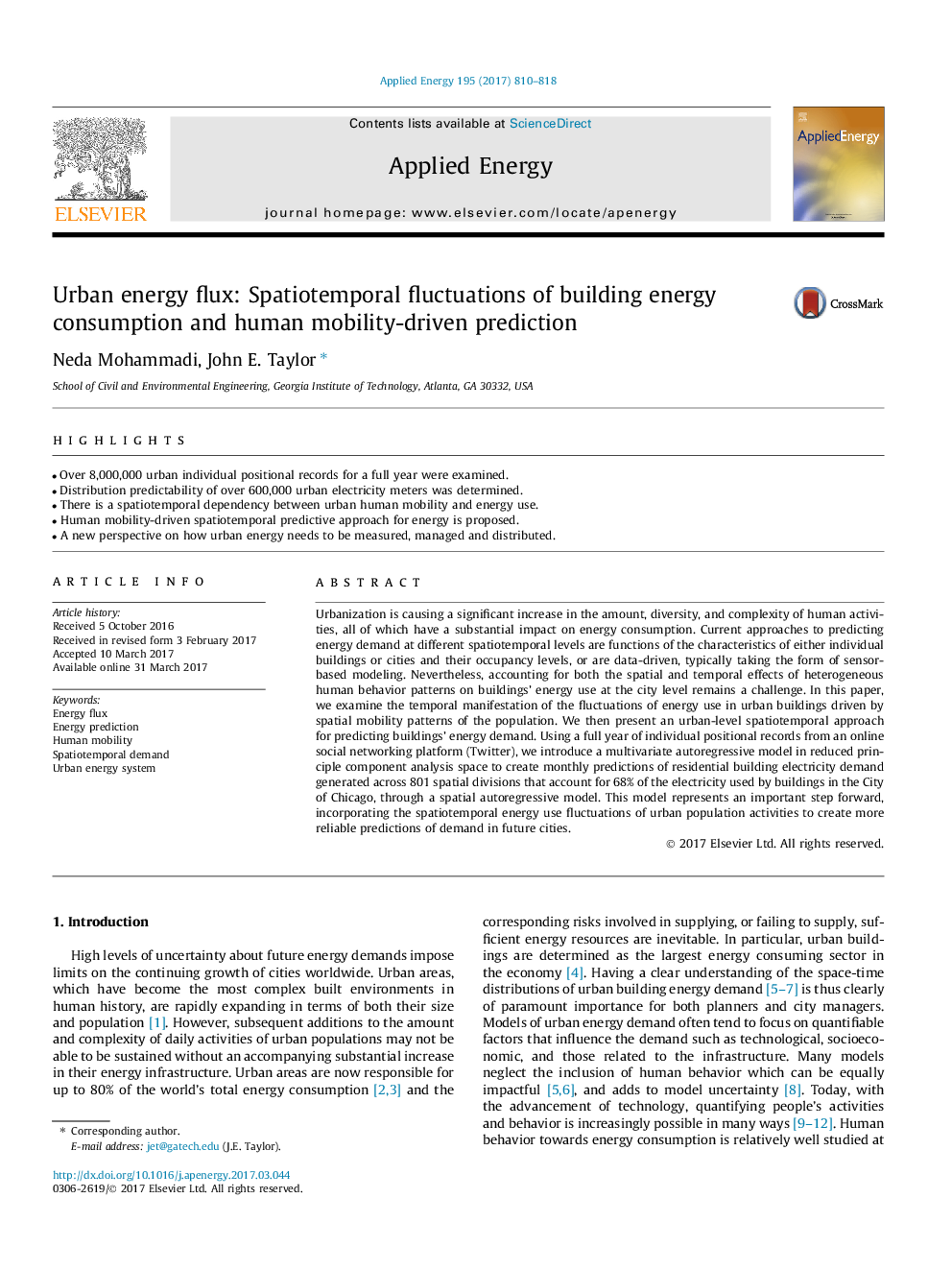| کد مقاله | کد نشریه | سال انتشار | مقاله انگلیسی | نسخه تمام متن |
|---|---|---|---|---|
| 4916523 | 1428095 | 2017 | 9 صفحه PDF | دانلود رایگان |
عنوان انگلیسی مقاله ISI
Urban energy flux: Spatiotemporal fluctuations of building energy consumption and human mobility-driven prediction
ترجمه فارسی عنوان
شار انرژی شهری: نوسانات زمانی و مکانی مصرف انرژی ساختمان و پیش بینی تحرک انسانی
دانلود مقاله + سفارش ترجمه
دانلود مقاله ISI انگلیسی
رایگان برای ایرانیان
کلمات کلیدی
شار انرژی، پیش بینی انرژی، تحرک بشر، تقاضای اسپکتیو موقت، سیستم انرژی شهری،
ترجمه چکیده
شهرنشینی باعث افزایش قابل توجهی در میزان، تنوع و پیچیدگی فعالیت های انسانی می شود که همه آنها تاثیر قابل توجهی در مصرف انرژی دارند. رویکردهای فعلی برای پیش بینی تقاضای انرژی در سطوح مختلف فضایی، توابع ویژگی های هر یک از ساختمان های فردی یا شهرها و سطح اشغال آنها هستند یا به صورت داده ای هدایت می شوند، معمولا به شکل مدل سازی مبتنی بر سنسور می پردازند. با این وجود، حسابداری برای هر دو اثر فضایی و زمانی از الگوهای رفتار ناهمگون انسان در استفاده از انرژی ساختمان در سطح شهر همچنان یک چالش است. در این مقاله، ما تجلی موقت نوسانات استفاده از انرژی در ساختمان های شهری را که بر اساس الگوهای حرکتی فضایی جمعیت است، بررسی می کنیم. سپس ما یک رویکرد فضایی زمانه ای در سطح شهر برای پیش بینی تقاضای انرژی ساختمان ها ارائه می دهیم. با استفاده از یک سال کامل سوابق موقعیت های شخصی از پلت فرم شبکه های اجتماعی آنلاین (توییتر)، ما یک مدل چندگانه ای را در فضای تجزیه و تحلیل جزء کاهش یافته به منظور ایجاد پیش بینی های ماهانه از تقاضای برق ساختمان مسکونی در 801 تقسیم فضایی که 68٪ از برق مورد استفاده در ساختمان های شهر شیکاگو، از طریق یک مدل اتفاقی فضایی. این مدل یک گام مهم برای جلوگیری از نوسانات استفاده از انرژی فضایی در فعالیت های جمعیت شهری است تا پیش بینی های قابل اطمینان بیشتری از تقاضا در شهرهای آینده ایجاد کند.
موضوعات مرتبط
مهندسی و علوم پایه
مهندسی انرژی
مهندسی انرژی و فناوری های برق
چکیده انگلیسی
Urbanization is causing a significant increase in the amount, diversity, and complexity of human activities, all of which have a substantial impact on energy consumption. Current approaches to predicting energy demand at different spatiotemporal levels are functions of the characteristics of either individual buildings or cities and their occupancy levels, or are data-driven, typically taking the form of sensor-based modeling. Nevertheless, accounting for both the spatial and temporal effects of heterogeneous human behavior patterns on buildings' energy use at the city level remains a challenge. In this paper, we examine the temporal manifestation of the fluctuations of energy use in urban buildings driven by spatial mobility patterns of the population. We then present an urban-level spatiotemporal approach for predicting buildings' energy demand. Using a full year of individual positional records from an online social networking platform (Twitter), we introduce a multivariate autoregressive model in reduced principle component analysis space to create monthly predictions of residential building electricity demand generated across 801 spatial divisions that account for 68% of the electricity used by buildings in the City of Chicago, through a spatial autoregressive model. This model represents an important step forward, incorporating the spatiotemporal energy use fluctuations of urban population activities to create more reliable predictions of demand in future cities.
ناشر
Database: Elsevier - ScienceDirect (ساینس دایرکت)
Journal: Applied Energy - Volume 195, 1 June 2017, Pages 810-818
Journal: Applied Energy - Volume 195, 1 June 2017, Pages 810-818
نویسندگان
Neda Mohammadi, John E. Taylor,
